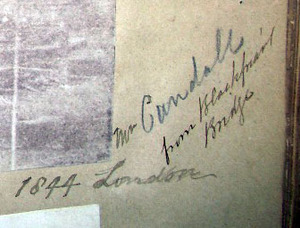One day in 1844, twenty-six year old Joseph Cundall walked from his printing shop on Old Bond Street down to the Thames River carrying the box camera he recently designed and built, along with bottles of’ silver nitrate and gallic acid. Once settled on the Blackfriars Bridge, under a black cloth, he painted the chemistry onto some writing paper that had already been treated with silver nitrate and potassium iodide and then, inserted it into the camera. Focusing on St. Paul’s Cathedral in the distance, Cundall opened the lens and made a single exposure.
This calotype (paper negative) was used later to make several positive prints, one of which was given to his friend, optician Richard Willats, who pasted it into an album. That album and what might be the earliest photograph taken by Joseph Cundall is now at Princeton University.
The Victorian children’s book publisher, Joseph Cundall (1818-1895), was also a pioneer in the art of photography, working in London at the same time as William Henry Fox Talbot. While Talbot was proprietary and secretive, Cundall often joined forces with others and was responsible for the careers of many young artists. Together with Robert Hunt, he founded the Calotype Club in 1847 and later, was a founding member of the Royal Photographic Society of London. In 1852, he established The Photographic Institution at 168 New Bond Street, which became ground zero for all photographic activity at the time. His career culminated in 1871 when the British Government sent him to Bayeux to organize the first photographic record of the famous tapestry.

